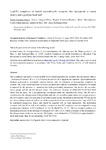Mostrar o rexistro simple do ítem
Lead(II) complexes of lateral macrobicyclic receptors that incorporate a crown moiety and a pyridine head unit
| dc.contributor.author | Esteban-Gómez, David | |
| dc.contributor.author | Enríquez-Pérez, Teresa | |
| dc.contributor.author | Ferreirós-Martínez, Raquel | |
| dc.contributor.author | Mato-Iglesias, Marta | |
| dc.contributor.author | Platas-Iglesias, Carlos | |
| dc.contributor.author | Blas, Andrés de | |
| dc.contributor.author | Rodríguez-Blas, Teresa | |
| dc.date.accessioned | 2020-04-02T11:30:39Z | |
| dc.date.available | 2020-04-02T11:30:39Z | |
| dc.date.issued | 2010-11 | |
| dc.identifier.citation | Esteban‐Gómez, D., Enríquez‐Pérez, T., Ferreirós‐Martínez, R., Mato‐Iglesias, M., Platas‐Iglesias, C., de Blas, A. and Rodríguez‐Blas, T. (2010), Lead(II) Complexes of Lateral Macrobicyclic Receptors That Incorporate a Crown Moiety and a Pyridine Head Unit. Eur. J. Inorg. Chem., 2010: 5027-5034. | es_ES |
| dc.identifier.issn | 1099-0682 | |
| dc.identifier.uri | http://hdl.handle.net/2183/25289 | |
| dc.description.abstract | [Abstract] The coordinative properties towards lead(II) of two lateral macrobicyclic receptors that incorporate either a 1,10‐diaza‐[15]crown‐5 (L7) or a 4,13‐diaza‐[18]crown‐6 (L8) fragment are reported. Spectrophotometric titrations performed in acetonitrile solution indicate only the formation of mononuclear complexes in solution. The X‐ray crystal structures of the two receptors show that the conformation adopted by the ligand is imposed by the presence of intramolecular hydrogen‐bonding interactions that involve the secondary amine groups and the pivotal nitrogen atoms. The solid‐state structure of [Pb(L7)(NCS)](SCN)·0.5H2O shows that the metal ion is asymmetrically coordinated inside the macrobicyclic cavity. The PbII ion is coordinated to the nitrogen atom of the pyridine unit, the two secondary amine atoms, two oxygen atoms of the crown moiety, and a nitrogen atom of an isothiocyanate group. The distances between the PbII ion and the two pivotal nitrogen atoms as well as one of the oxygen atoms of the crown moiety are too long (>2.92 Å) to be considered unequivocal bonds, and should be regarded only as weak interactions. The protonation constants of L7 and L8 as well as the stability constants of their PbII complexes were investigated by using potentiometric titrations in 95 % methanol (I = 0.1 M, nBu4NClO4, 25 °C). The two receptors undergo two protonation processes in the pH range investigated (2.0 < pH < 12.0), which correspond to the protonation of the nitrogen atoms of the oxa–aza moiety. The log KPbL value obtained for L7 [9.906(1)] is approximately 1.1 log K units higher than the one determined for L8 [8.75(1)]. | es_ES |
| dc.description.sponsorship | Xunta de Galicia; PGIDIT06TAM10301PR | es_ES |
| dc.description.sponsorship | Xunta de Galicia; INCITE09E1R103013ES | es_ES |
| dc.language.iso | eng | es_ES |
| dc.publisher | Wiley | es_ES |
| dc.relation.uri | https://doi.org/10.1002/ejic.201000642 | es_ES |
| dc.rights | This is the peer reviewed version of the following article: Esteban‐Gómez, D., Enríquez‐Pérez, T., Ferreirós‐Martínez, R., Mato‐Iglesias, M., Platas‐Iglesias, C., de Blas, A. and Rodríguez‐Blas, T. (2010), Lead(II) Complexes of Lateral Macrobicyclic Receptors That Incorporate a Crown Moiety and a Pyridine Head Unit. Eur. J. Inorg. Chem., 2010: 5027-5034 which has been published in final form at https://doi.org/10.1002/ejic.201000642. This article may be used for non-commercial purposes in accordance with Wiley Terms and Conditions for Use of Self-Archived Versions. | es_ES |
| dc.subject | Macrocycles | es_ES |
| dc.subject | N,O ligands | es_ES |
| dc.subject | Lead | es_ES |
| dc.subject | Crown compounds | es_ES |
| dc.subject | Cryptands | es_ES |
| dc.title | Lead(II) complexes of lateral macrobicyclic receptors that incorporate a crown moiety and a pyridine head unit | es_ES |
| dc.type | info:eu-repo/semantics/article | es_ES |
| dc.rights.access | info:eu-repo/semantics/openAccess | es_ES |
| UDC.journalTitle | European Journal of Inorganic Chemistry | es_ES |
| UDC.volume | 2010 | es_ES |
| UDC.issue | 31 | es_ES |
| UDC.startPage | 5027 | es_ES |
| UDC.endPage | 5034 | es_ES |
Ficheiros no ítem
Este ítem aparece na(s) seguinte(s) colección(s)
-
GI-REACT! - Artigos [107]






